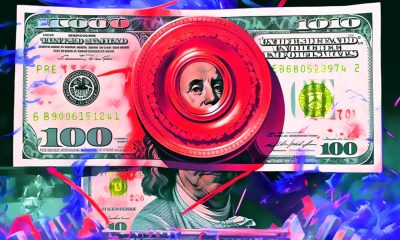

others
US Dollar steady with ECB comments moving markets this Monday – Crypto News
- The US Dollar index (DXY) saw a bearish weekly close on Friday night.
- US markets are closed due to the Memorial Day holiday on Monday.
- The US Dollar could ease further after an important daily and weekly close on the charts.
The US Dollar (USD) trades a little softer against most major peers on Monday as there is not much to report for the Greenback, with US markets closed for the Memorial Day holidays. However, on the other side of the Atlantic Ocean, a change in stance on the European Central Bank (ECB) is starting to form.
There is a very quiet economic data calendar on Monday. Most of this week will be rather quiet, with only some soft data and US Federal Reserve (Fed) speeches ahead towards Thursday. Then, the second estimate for the Q1 US Gross Domestic Product (GDP) on Thursday and April’s US Personal Consumption Expenditures (PCE) numbers on Friday could hit markets and leave more clues on the disinflationary pathway in the US and what the Fed might do next.
Daily digest market movers: ECB takes over headlines
- French ECB member François Villeroy de Galhau hinted that a second cut in July should not be excluded. This goes against the ‘one and done’ overall message most ECB members have been communicating.
- Traders are still looking into more details on a headline from Friday where President Vladimir Putin said to be willing to have a ceasefire and start up peace talks if current frontlines can be adhered to as new official borders.
- ECB Chief Economist Philip Lane said that an interest rate cut in June looks a given, though it might take longer for the next cut. This completely goes against the three-cut expectations from the markets, with several ECB policymakers recently saying that a June rate cut might be a ‘one and done’ for 2024.
- There is risk-on sentiment across the board, with China and Europe markets comfortably in the green.
- The CME Fedwatch Tool is pricing 99.1% for no change in the policy rate for June. September futures are seeing more action, where it is a neck-and-neck race with 50.2% chances for keeping rates unchanged against 44.9% chances for a 25 basic points (bps) rate cut and 4.5% chances for even 50 bps rate cut. A marginal 0.5% price in an interest rate hike.
- The benchmark 10-year US Treasury Note trades around 4.46% and is not moving on Monday with the US bank holiday.
US Dollar Index Technical Analysis: Chopping up levels
The US Dollar Index (DXY) faces a bit of a horror story on the technical front after its weekly close on Friday. First of all, on the weekly chart, the DXY closed below the 100-week Simple Moving Average (SMA), which is a severe bearish signal and could point to a further downturn. A similar picture is seen on the daily chart, where the DXY was unable to stay afloat above the 55-day SMA at 104.86 and gave up its gains for the week above 105.00.
On the upside, the DXY index needs to reclaim those levels it lost last week: the 55-day Simple Moving Average (SMA) at 104.86 and the 105.00 big round level. Further up, the following levels to consider are 105.12 and 105.52.
On the downside, the 200-day SMA at 104.40 and the 100-day SMA around 104.30 are the last line of defence. Once that level snaps, an air pocket is placed between 104.30 and 103.00. Should the US Dollar decline persist, the low of March at 102.35 and the low from December at 100.62 are levels to consider.
Risk sentiment FAQs
In the world of financial jargon the two widely used terms “risk-on” and “risk off” refer to the level of risk that investors are willing to stomach during the period referenced. In a “risk-on” market, investors are optimistic about the future and more willing to buy risky assets. In a “risk-off” market investors start to ‘play it safe’ because they are worried about the future, and therefore buy less risky assets that are more certain of bringing a return, even if it is relatively modest.
Typically, during periods of “risk-on”, stock markets will rise, most commodities – except Gold – will also gain in value, since they benefit from a positive growth outlook. The currencies of nations that are heavy commodity exporters strengthen because of increased demand, and Cryptocurrencies rise. In a “risk-off” market, Bonds go up – especially major government Bonds – Gold shines, and safe-haven currencies such as the Japanese Yen, Swiss Franc and US Dollar all benefit.
The Australian Dollar (AUD), the Canadian Dollar (CAD), the New Zealand Dollar (NZD) and minor FX like the Ruble (RUB) and the South African Rand (ZAR), all tend to rise in markets that are “risk-on”. This is because the economies of these currencies are heavily reliant on commodity exports for growth, and commodities tend to rise in price during risk-on periods. This is because investors foresee greater demand for raw materials in the future due to heightened economic activity.
The major currencies that tend to rise during periods of “risk-off” are the US Dollar (USD), the Japanese Yen (JPY) and the Swiss Franc (CHF). The US Dollar, because it is the world’s reserve currency, and because in times of crisis investors buy US government debt, which is seen as safe because the largest economy in the world is unlikely to default. The Yen, from increased demand for Japanese government bonds, because a high proportion are held by domestic investors who are unlikely to dump them – even in a crisis. The Swiss Franc, because strict Swiss banking laws offer investors enhanced capital protection.
-

 Blockchain1 week ago
Blockchain1 week agoRobinhood Dealing With Fallout of Tokenized Equities Offering – Crypto News
-

 Cryptocurrency1 week ago
Cryptocurrency1 week agoWhale Sells $407K TRUMP, Loses $1.37M in Exit – Crypto News
-

 Cryptocurrency1 week ago
Cryptocurrency1 week agoSatoshi-Era Bitcoin Whale Moves Another $2.42 Billion, What’s Happening? – Crypto News
-

 Blockchain7 days ago
Blockchain7 days agoRipple and Ctrl Alt Team to Support Real Estate Tokenization – Crypto News
-
Technology7 days ago
Fed Rate Cut Odds Surge As Powell’s Future Hangs In The Balance – Crypto News
-

 Cryptocurrency1 week ago
Cryptocurrency1 week agoCardano’s $1.22 target: Why traders should be aware of THIS ADA setup – Crypto News
-

 Cryptocurrency1 week ago
Cryptocurrency1 week agoBitcoin Breaches $120K, Institutional FOMO Takes and House Debate Propel Gains – Crypto News
-
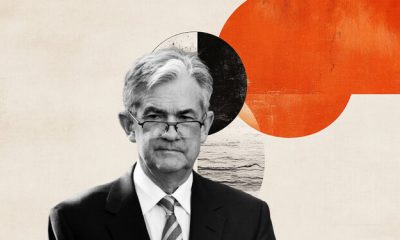
 others7 days ago
others7 days agoEUR/USD recovers with trade talks and Fed independence in focus – Crypto News
-
Technology7 days ago
Fed Rate Cut Odds Surge As Powell’s Future Hangs In The Balance – Crypto News
-
Cryptocurrency1 week ago
Why Is Bitcoin Up Today? – Crypto News
-

 Blockchain1 week ago
Blockchain1 week agoUK Banks Should not Issue Stablecoins – Crypto News
-

 Cryptocurrency1 week ago
Cryptocurrency1 week agoDonald Trump Jr. backs social media startup aiming to become a crypto powerhouse – Crypto News
-
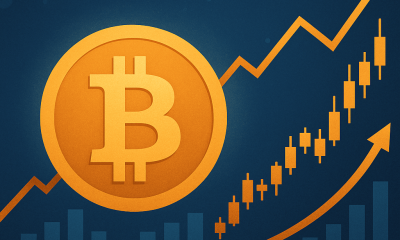
 Blockchain1 week ago
Blockchain1 week agoThe Bitcoin Liquidity Supercycle Has Just Begun: Hedge Fund CEO – Crypto News
-

 Cryptocurrency1 week ago
Cryptocurrency1 week agoStrategy Resumes Bitcoin Buys, Boosting Holdings to Over $72 Billion in BTC – Crypto News
-
Business1 week ago
Pepe Coin Rich List June 2025: Who’s Holding Highest PEPE as it Nears Half a Million Holders? – Crypto News
-

 Cryptocurrency1 week ago
Cryptocurrency1 week agoIt’s a Statement, Says Bitfinex Alpha – Crypto News
-

 Cryptocurrency6 days ago
Cryptocurrency6 days agoBitcoin trades near $119K after new all-time high; Coinbase rebrands wallet to ‘Base App’ – Crypto News
-
Business6 days ago
XLM Is More Bullish Than ETH, SOL, And XRP, Peter Brandt Declares – Crypto News
-

 Technology1 week ago
Technology1 week agoGoogle, Anthropic, OpenAI and xAI join US defence to tackle national security with AI – Crypto News
-
![Stellar [XLM] bulls exhausted after rally - Is a pullback nearby?](https://dripp.zone/news/wp-content/uploads/2025/07/Stellar-XLM-bulls-exhausted-after-rally-Is-a-pullback.webp-400x240.webp)
![Stellar [XLM] bulls exhausted after rally - Is a pullback nearby?](https://dripp.zone/news/wp-content/uploads/2025/07/Stellar-XLM-bulls-exhausted-after-rally-Is-a-pullback.webp-80x80.webp) Cryptocurrency1 week ago
Cryptocurrency1 week agoStellar [XLM] bulls exhausted after rally – Is a pullback nearby? – Crypto News
-
Cryptocurrency1 week ago
Fed’s Hammack Raises Inflation Concerns Amid Push For Interest Rate Cut – Crypto News
-

 Cryptocurrency1 week ago
Cryptocurrency1 week ago1inch price forecast: 1INCH hits 7-month high after double digit gains – Crypto News
-

 Cryptocurrency1 week ago
Cryptocurrency1 week ago1inch price forecast: 1INCH hits 7-month high after double digit gains – Crypto News
-

 others7 days ago
others7 days agoTop Crypto Exchange by Trading Volume Binance Announces Airdrop for New Ethereum (ETH) Ecosystem Altcoin – Crypto News
-

 others6 days ago
others6 days agoVanEck Details Key Drivers Boosting Bitcoin Price, Including Corporate Treasury Demand, ETF Flows and More – Crypto News
-
Business6 days ago
XRP Lawsuit Update: Ripple Paid $125M in Cash, Settlement Hinges on Appeal – Crypto News
-

 Cryptocurrency5 days ago
Cryptocurrency5 days agoAnarchy, crime and stablecoins – Blockworks – Crypto News
-
Business1 week ago
CME XRP Futures Hit $1.6B In Total Trading Volume Since Launch – Crypto News
-

 Technology1 week ago
Technology1 week agoV Guard INSIGHT-G BLDC fan review: Cool performer with a premium look – Crypto News
-
Technology1 week ago
XLM Price Forecast: Why Stellar Lumens May Crash After 80% Rally in Last 7 Days – Crypto News
-

 Metaverse1 week ago
Metaverse1 week agoWhy voice is emerging as India’s next frontier for AI interaction – Crypto News
-

 Metaverse1 week ago
Metaverse1 week agoNvidia’s Jensen Huang says AI ‘fundamental like electricity’, praises Chinese models as ‘catalyst for global progress’ – Crypto News
-
Business7 days ago
Ethereum Price Prediction- Bulls Target $3,700 As ETH Treasury Accumulation Soars – Crypto News
-
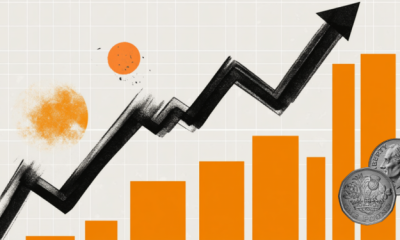
 others6 days ago
others6 days agoGBP/USD rallies on US PPI dip and Trump’s potential Powell removal – Crypto News
-

 others6 days ago
others6 days agoGBP/USD rallies on US PPI dip and Trump’s potential Powell removal – Crypto News
-
Cryptocurrency6 days ago
Russia’s $85 Billion Sberbank to Launch Crypto Custody Services – Crypto News
-

 De-fi1 week ago
De-fi1 week agoRobinhood Opens Ether and Solana Staking to US Users – Crypto News
-

 Cryptocurrency1 week ago
Cryptocurrency1 week agoTop 3 altcoins under $1 worth watching: Sei, Ethena, Arbitrum – Crypto News
-

 Blockchain1 week ago
Blockchain1 week agoAltcoins Chase New Highs After Bitcoin Hits $123,000 – Crypto News
-

 De-fi1 week ago
De-fi1 week agoRipple’s RLUSD Market Cap Passes $515M, Flips TrueUSD – Crypto News
-
others1 week ago
Bitcoin Critic Vanguard Becomes Strategy’s (MSTR) Largest Shareholder – Crypto News
-

 De-fi1 week ago
De-fi1 week agoDeFi TVL Surges Past $126B, Up Over 45% Since April – Crypto News
-
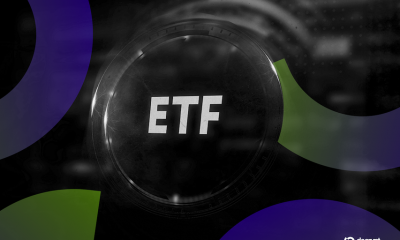
 Cryptocurrency1 week ago
Cryptocurrency1 week agoHypercharged Exposure to XRP and Solana Now Available With These Two ETFs – Crypto News
-

 Cryptocurrency1 week ago
Cryptocurrency1 week agoNothing Burger or Crypto Catalyst? – Crypto News
-

 Blockchain1 week ago
Blockchain1 week agoBitMine Shares Rallied After Peter Thiel Investment. – Crypto News
-
others1 week ago
Crypto Exchange Hack: BigONE Users Lose A Massive $27 Million In Recent Exploit – Crypto News
-
Cryptocurrency1 week ago
Pi Network Activity Soars as Mystery Wallet Acquires Millions in PI Coins – Crypto News
-

 Blockchain1 week ago
Blockchain1 week agoCitigroup CEO Confirms Interest In Issuing A Proprietary Stablecoin—Reuters – Crypto News
-

 others1 week ago
others1 week agoScammer Drains $10,000,000 From IRS in International Tax Fraud and Identity Theft Scheme: DOJ – Crypto News
-
Business1 week ago
XRP ETF Still in Play- SEC Commissioner Debunks Rejection Speculations – Crypto News







